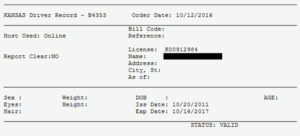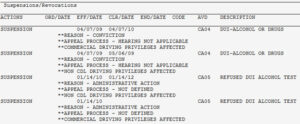Estimated Read Time: 5 Minutes

If you’ve ever looked at a driving record, you would know that they can be cryptic. I created this guide to be a reference material for employers to use when reading driving record reports on their applicants and employees.
While motor vehicle records from different suppliers may be arranged in different formats, they all come from the same source – the Department of Motor Vehicles (DMV). As such, there is somewhat of a universal language to learn that will help you decipher the information contained within the reports.
Note: there will sometimes be things on a driving record that are difficult to understand even with this reference guide. If you are ever unsure of the information contained in a report, don’t make assumptions about the information. Call your provider to clarify.
General Information
The following are images from sample reports provided by Validity Screening Solutions. Again, if you use a different provider the information may be displayed in a different way. Most driving records contain the same relative information.

In the “General Information” section of a driving record report, you will see – you guessed it – general information about the individual and their driver’s license. This is where you will see the individuals identifying information such as name, date of birth, and any other information commonly associated with a driver’s license.
You will see on this example that there are some blank fields on the report. Each state DMV has its own policy towards what information it will provide for driving record checks. As such, they might not include additional identifying information like height, weight, or current address.
License Status
The license status is an important piece of the general information section that will tell you whether the license provided by the individual is valid, expired, cancelled, withdrawn, or suspended. This is crucial information to have for employees that will be driving on the organization’s time.
Licenses are suspended more often than you might think. If a ticket isn’t paid or the individual failed to verify their address in certain circumstances, the issuing state may suspend their license. In these instances, the individual may not know that their license is even suspended.
Violations


Most of the information that gets lost in translation from a driving record report is the violations section. It is in this section that you will start seeing tables full of abbreviations, codes, and driving record terms that you may be unfamiliar with. I’ll break it down into the key components so that you can use this as your reference.
Abbreviations
TYPE: type of incident (traffic violation, accident, etc.).
VIOL: Date of violation.
CONV: date the driver was either convicted in court or settled via mail.
ACD: ACD Codes refer to codes from the American Association of Motor Vehicle Administrators (AAMVA) and are the code that states attach to describe violations. Each state has a unique set of codes.
AVD: codes used by our provider for the lookup of the ACD code and description by state so they don’t have to search a database for each state.
V/C: Vehicle Code of the violation (determining who takes departmental action – zoning violation, noise violation, etc.).
C: Commercial Vehicle (Y/N).
SPEED: Speed of the vehicle if it was a speeding violation. Represented as (speed of the vehicle/speed limit).
LOCATION/DOCKET: Location of the incident.
ACCIDENT: Was there an accident involved (Y/N).
PT: points assessed as punishment for the violation. Too many points may result in suspension or revocation of the license.
Driving Record Suspensions and Revocations
In this section of the driving record, any current or previous suspensions, revocations, reinstatements, etc. will be displayed with any relevant supporting information.

Order date: the date the courts ordered the action.
Effective date: the date the action takes effect.
Clear date: the date the driver can apply for reinstatement from the DMV.
End date: the date the action ends with the DMV.
The suspensions section will also contain AVD codes for each listed action. The AVD codes come from the same list as those from the previous section on the record. Most Items will have a description that accompanies it. These will help give a picture of the reasoning for each suspension or revocation.
Medical Certificates
For many commercial driver’s licenses, a medical examiner must certify that they have examined the driver to determine whether they are physically qualified to operate a Commercial Motor Vehicle, and at what capacity. Some states will include the medical certificate information associated with that license in a driving record.

Self-Certificate Type: will be listed as one of four certificate types: Excepted Interstate, Non-Excepted Interstate, Excepted Intrastate, or Non-Excepted Intrastate.
Issued: date certificate was issued.
Effective: date the certificate was processed through the DMV and becomes active. If your driver obtained the medical certificate two weeks ago but only sent in the required paperwork yesterday, the effective date would be different.
Downgraded: failure to maintain a current medical certificate may result in a downgrade of the driver’s commercial license to a non-commercial license.
Status: states whether the driver cleared their medical certification.
Restrictions: medical restrictions, usually corrective lenses, if required, but some drivers may have a work restriction where they can only operate a commercial vehicle while working, or perhaps they may only operate during the daytime.
Medical Examiner Information: information regarding the medical examiner.
A few final thoughts
Again, I want to stress that it’s understandable if some of the content in a driving record is difficult to interpret. If you run into a situation where you are unsure what a violation is or if it is relevant to your hiring process, ask us. While we can’t help you make your hiring decision, we can certainly make sure you are making that decision based on accurate information.